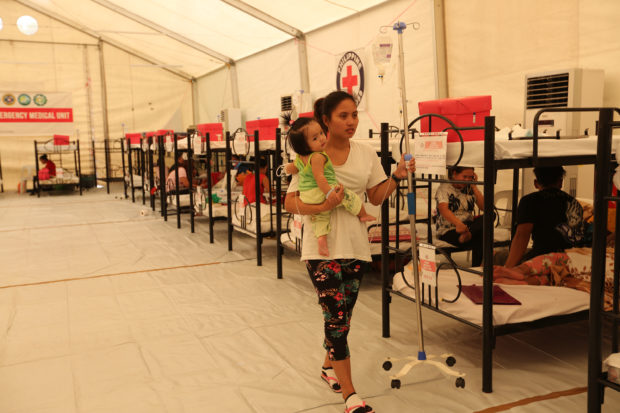
DENGUE TENT Inside the emergency tent installed by the Philippine National Red Cross in Dasmariñas, Cavite. —JOAN BONDOC
MANILA, Philippines — Health Secretary Francisco Duque III on Tuesday urged the public to immediately seek treatment once they experience symptoms of dengue to help curb the number of deaths due to the mosquito-borne disease, which remains to be the highest throughout Southeast Asia.
Duque said that although the increase in the number of dengue cases in the country is not as deeply concerning as that of its neighbors, the Philippines “continues to have the highest case fatality rate” at 0.3 percent.
Apart from the Philippines, a dengue epidemic is also being experienced in Malaysia, Thailand, Laos, Vietnam, Singapore and Indonesia.
As of July 27, the Department of Health (DOH) has already recorded a total of 167,607 dengue cases and 720 deaths nationwide.
“It’s because sometimes the response is late. That’s why we are appealing to the parents that if your child has fever for two days or more [they should already seek treatment],” Duque told reporters.
‘Milder’ strain
Of the four dengue strains, Dengue 3 is the predominant strain this year, accounting for 72 percent of all confirmed cases.
Though “milder,” this strain, and Dengue 4, cause fever, muscle pains, headache, loss of appetite, vomiting and diarrhea.
On Tuesday, Duque led a “search and destroy” activity inside the DOH compound in Manila where he saw a makeshift planter box and an outdoor ornamental jar to have been filled with stagnant water due to the rains Monday night.
Duque said it was important for the public to take notice of their surroundings as things like these, which are often overlooked, are where dengue-carrying mosquitoes can breed.
To date, 10 regions have already breached the epidemic threshold, with Western Visayas, Calabarzon (Cavite, Laguna, Batangas, Rizal and Quezon) and Zamboanga Peninsula having the highest number of cases in the country.
Ilocos and the National Capital Region (NCR) are meanwhile being monitored as they near the alert threshold.
While the total dengue cases in NCR is still below than that of last year’s, 10 cities have already reported higher numbers as of Aug. 3.
Also on Tuesday, the women’s rights group Gabriela, Salinlahi Alliance for Children’s Concerns and the Gabriela Women’s party expressed alarm over the recorded dengue cases in the country, with 720 deaths so far.
The group blamed the government’s “negligence” on public health services and its failure to install budgetary safeguards over the state’s health funds as fueling the dengue epidemic.
“In 2017, dengue was also a pressing issue. But this current wave of dengue cases brings our country to the top spot of most dengue cases in Southeast Asia … over a disease that could have been prevented,” Gabriela secretary general Joms Salvador said during a press conference in Quezon City.
Higher budget needed
For Gabriela Women’s Party Rep. Arlene Brosas, the current health crisis could’ve been easily addressed with a higher budget for health services.
“During the deliberations for the 2019 budget, we opposed the move to cut the maintenance and other operating expenses (MOOE) of public hospitals by P1 billion,” said Brosas.
“The 10.25 percent decrease in MOOE of national specialty hospitals and the 11.81 percent decrease for regional hospitals have a negative impact on poor Filipinos,” she said.
In 2018, Congress approved the P1.161 billion supplemental budget on health for medical assistance to people injected with the Dengvaxia vaccine.
Under House Bill No. 7449, the fund will be used exclusively for human resource for health deployment, public health management, and assistance to indigent patients, whether confined or not.
According to Brosas, the DOH should be transparent on how the fund was being utilized now that a national epidemic had been declared, with patients who did not receive doses of Dengvaxia.